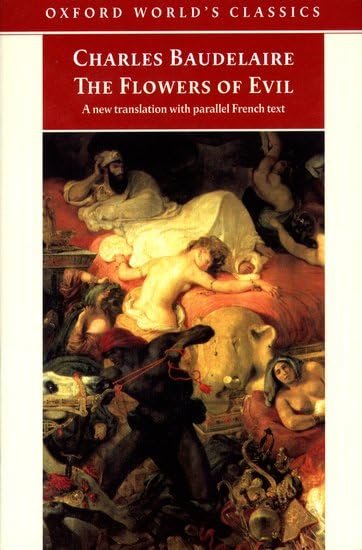The Flowers of Evil
Charles Baudelaire
BOOK REVIEW

In the dimly lit corners of the literary world, where shadows mingle with the harsh glare of societal norms, lies Charles Baudelaire's revolutionary collection, The Flowers of Evil. This masterpiece doesn't just emerge as a book; it erupts like a melancholic symphony, echoing the dissonance of the human experience. Baudelaire beckons you, imploring you to peel away the layers of convention and embrace the profound beauty hidden beneath the surface of vice and despair.
Published in 1857, a time when the world clung resolutely to Victorian morals, Baudelaire's work was nothing short of scandalous. It clashed with the era's genteel sensibilities, making its author an immediate target for criticism and legal challenges. How audacious, some would think, to elevate themes of decadence, eroticism, and existential angst to the realm of art! Yet, this was precisely Baudelaire's aim: to forge an unfiltered lens through which humanity could gaze upon its tumultuous soul.
The first striking feature of The Flowers of Evil is its unapologetic confrontation with the grotesque. The poems, rich in symbolism, unravel the intricacies of sin and redemption. Baudelaire intertwines beauty with decay, illustrating that pleasure and pain, light and dark, coexist in a delicate dance. In his verses, you can almost feel the pulse of Paris, a city teetering between grandeur and squalor. This backdrop isn't merely a setting; it becomes a character in its own right-a canvas splashed with the hues of life's ecstasy and agony.
Readers have been divided by Baudelaire's audacity. Some hail him as a visionary, a harbinger of modernist thought that transcends time and cultural barriers. Others recoil at the sheer boldness of his subject matter, labeling it as indecent or morose. Those who dare to embark on this literary journey, however, often find themselves enraptured by the raw honesty of his work. The brilliance lies not just in the palpable visceral reactions but in the contemplative silence that follows-a moment to digest the weight of his observations on existence.
Consider, for a moment, the impact of Baudelaire on future generations. His influence ripples through the works of poets like T.S. Eliot and Sylvia Plath, whose anguished musings reflect his signature style of combining beauty with the macabre. One could argue that without The Flowers of Evil, the landscape of modern poetry would appear distinctly different. Baudelaire carved out space for artists to explore their innermost turmoils, and as a result, art expanded into uncharted territories.
Moreover, his exploration of the concept of "spleen"-that deep-seated existential malaise-resonates profoundly today. In a world grappling with increasing mental health challenges, Baudelaire's depiction of isolation and introspection speaks to many with shocking clarity. The reader is compelled to confront their own feelings of ennui, to acknowledge the darkness that exists alongside the light. This emotional resonance is what makes Baudelaire's work timeless-it transcends the boundaries of the 19th century and pierces through the veil of modern existence.
The titles of his poems might provoke a raised eyebrow or a hushed gasp: "The Litanies of Satan," "The Vampire," and "The Death of Lovers." These are not mere words; they are invitations to engage with the darker facets of life. They urge you to grapple with the uncomfortable, to embrace the ugly truths that our sanitized world often seeks to bury. Herein lies the audacity of Baudelaire: he confronts the reader not only with beauty but also with unvarnished reality.
Critics have poured forth divergent opinions-some praising his masterful use of language and profound insights, while others lament the pessimism they perceive in his worldview. But what cannot be ignored is the undeniable power of his words. They linger long after the last poem is read, stirring the soul and igniting conversations that extend far beyond the literary realm.
In a time when societal norms dictate the boundaries of expression, Baudelaire dances between the flowers of evil and the essence of life itself. He implores you to confront the duality of existence, to explore the flora that blooms in the barren wastelands of the human psyche. The Flowers of Evil is more than just a collection; it's a perilous exploration of the heart and mind, an invitation to discover the beauty in chaos and the elegance in despair.
Dare you take the plunge into this intoxicating labyrinth? Your journey into the profound and the beautiful awaits. 🌹
📖 The Flowers of Evil
✍ by Charles Baudelaire
🧾 464 pages
1998
#baudelaire #CharlesBaudelaire